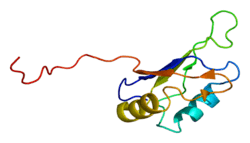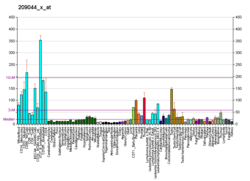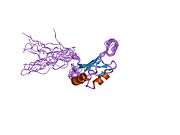SF3B4
Splicing factor 3B subunit 4 is a protein that in humans is encoded by the SF3B4 gene.[5][6]
Function
This gene encodes one of four subunits of the splicing factor 3B. The protein encoded by this gene cross-links to a region in the pre-mRNA immediately upstream of the branchpoint sequence in pre-mRNA in the prespliceosomal complex A. It also may be involved in the assembly of the B, C and E spliceosomal complexes. In addition to RNA-binding activity, this protein interacts directly and highly specifically with subunit 2 of the splicing factor 3B. This protein contains two N-terminal RNA-recognition motifs (RRMs), consistent with the observation that it binds directly to pre-mRNA.[6]
Disease associations
In 2012, Canadian researchers belonging to the FORGE (Finding of Rare disease GEnes) consortium identified new dominant mutations in SF3B4 as the cause of Nager syndrome, a rare type of mandibulofacial dysostosis with associated limb malformations.[7]
Interactions
SF3B4 has been shown to interact with CDC5L,[8] BMPR1A[9] and SF3B2.[5][10]
References
- 1 2 3 GRCh38: Ensembl release 89: ENSG00000143368 - Ensembl, May 2017
- 1 2 3 GRCm38: Ensembl release 89: ENSMUSG00000068856 - Ensembl, May 2017
- ↑ "Human PubMed Reference:".
- ↑ "Mouse PubMed Reference:".
- 1 2 Champion-Arnaud P, Reed R (Aug 1994). "The prespliceosome components SAP 49 and SAP 145 interact in a complex implicated in tethering U2 snRNP to the branch site". Genes & Development. 8 (16): 1974–83. doi:10.1101/gad.8.16.1974. PMID 7958871.
- 1 2 "Entrez Gene: SF3B4 splicing factor 3b, subunit 4, 49kDa".
- ↑ Bernier FP, Caluseriu O, Ng S, Schwartzentruber J, Buckingham KJ, Innes AM, Jabs EW, Innis JW, Schuette JL, Gorski JL, Byers PH, Andelfinger G, Siu V, Lauzon J, Fernandez BA, McMillin M, Scott RH, Racher H, Majewski J, Nickerson DA, Shendure J, Bamshad MJ, Parboosingh JS (May 2012). "Haploinsufficiency of SF3B4, a component of the pre-mRNA spliceosomal complex, causes Nager syndrome". American Journal of Human Genetics. 90 (5): 925–33. doi:10.1016/j.ajhg.2012.04.004. PMID 22541558.
- ↑ Ajuh P, Kuster B, Panov K, Zomerdijk JC, Mann M, Lamond AI (Dec 2000). "Functional analysis of the human CDC5L complex and identification of its components by mass spectrometry". The EMBO Journal. 19 (23): 6569–81. doi:10.1093/emboj/19.23.6569. PMC 305846. PMID 11101529.
- ↑ Nishanian TG, Waldman T (Oct 2004). "Interaction of the BMPR-IA tumor suppressor with a developmentally relevant splicing factor". Biochemical and Biophysical Research Communications. 323 (1): 91–7. doi:10.1016/j.bbrc.2004.08.060. PMID 15351706.
- ↑ Rual JF, Venkatesan K, Hao T, Hirozane-Kishikawa T, Dricot A, Li N, Berriz GF, Gibbons FD, Dreze M, Ayivi-Guedehoussou N, Klitgord N, Simon C, Boxem M, Milstein S, Rosenberg J, Goldberg DS, Zhang LV, Wong SL, Franklin G, Li S, Albala JS, Lim J, Fraughton C, Llamosas E, Cevik S, Bex C, Lamesch P, Sikorski RS, Vandenhaute J, Zoghbi HY, Smolyar A, Bosak S, Sequerra R, Doucette-Stamm L, Cusick ME, Hill DE, Roth FP, Vidal M (Oct 2005). "Towards a proteome-scale map of the human protein-protein interaction network". Nature. 437 (7062): 1173–8. doi:10.1038/nature04209. PMID 16189514.
Further reading
- Maruyama K, Sugano S (Jan 1994). "Oligo-capping: a simple method to replace the cap structure of eukaryotic mRNAs with oligoribonucleotides". Gene. 138 (1–2): 171–4. doi:10.1016/0378-1119(94)90802-8. PMID 8125298.
- Suzuki Y, Yoshitomo-Nakagawa K, Maruyama K, Suyama A, Sugano S (Oct 1997). "Construction and characterization of a full length-enriched and a 5'-end-enriched cDNA library". Gene. 200 (1–2): 149–56. doi:10.1016/S0378-1119(97)00411-3. PMID 9373149.
- Neubauer G, King A, Rappsilber J, Calvio C, Watson M, Ajuh P, Sleeman J, Lamond A, Mann M (Sep 1998). "Mass spectrometry and EST-database searching allows characterization of the multi-protein spliceosome complex". Nature Genetics. 20 (1): 46–50. doi:10.1038/1700. PMID 9731529.
- Das BK, Xia L, Palandjian L, Gozani O, Chyung Y, Reed R (Oct 1999). "Characterization of a protein complex containing spliceosomal proteins SAPs 49, 130, 145, and 155". Molecular and Cellular Biology. 19 (10): 6796–802. doi:10.1128/mcb.19.10.6796. PMC 84676. PMID 10490618.
- Das R, Zhou Z, Reed R (May 2000). "Functional association of U2 snRNP with the ATP-independent spliceosomal complex E". Molecular Cell. 5 (5): 779–87. doi:10.1016/S1097-2765(00)80318-4. PMID 10882114.
- Will CL, Schneider C, MacMillan AM, Katopodis NF, Neubauer G, Wilm M, Lührmann R, Query CC (Aug 2001). "A novel U2 and U11/U12 snRNP protein that associates with the pre-mRNA branch site". The EMBO Journal. 20 (16): 4536–46. doi:10.1093/emboj/20.16.4536. PMC 125580. PMID 11500380.
- Will CL, Urlaub H, Achsel T, Gentzel M, Wilm M, Lührmann R (Sep 2002). "Characterization of novel SF3b and 17S U2 snRNP proteins, including a human Prp5p homologue and an SF3b DEAD-box protein". The EMBO Journal. 21 (18): 4978–88. doi:10.1093/emboj/cdf480. PMC 126279. PMID 12234937.
- Golas MM, Sander B, Will CL, Lührmann R, Stark H (May 2003). "Molecular architecture of the multiprotein splicing factor SF3b". Science. 300 (5621): 980–4. doi:10.1126/science.1084155. PMID 12738865.
- Lehner B, Semple JI, Brown SE, Counsell D, Campbell RD, Sanderson CM (Jan 2004). "Analysis of a high-throughput yeast two-hybrid system and its use to predict the function of intracellular proteins encoded within the human MHC class III region". Genomics. 83 (1): 153–67. doi:10.1016/S0888-7543(03)00235-0. PMID 14667819.
- Will CL, Schneider C, Hossbach M, Urlaub H, Rauhut R, Elbashir S, Tuschl T, Lührmann R (Jun 2004). "The human 18S U11/U12 snRNP contains a set of novel proteins not found in the U2-dependent spliceosome". Rna. 10 (6): 929–41. doi:10.1261/rna.7320604. PMC 1370585. PMID 15146077.
- Nishanian TG, Waldman T (Oct 2004). "Interaction of the BMPR-IA tumor suppressor with a developmentally relevant splicing factor". Biochemical and Biophysical Research Communications. 323 (1): 91–7. doi:10.1016/j.bbrc.2004.08.060. PMID 15351706.
- Lin KT, Lu RM, Tarn WY (Oct 2004). "The WW domain-containing proteins interact with the early spliceosome and participate in pre-mRNA splicing in vivo". Molecular and Cellular Biology. 24 (20): 9176–85. doi:10.1128/MCB.24.20.9176-9185.2004. PMC 517884. PMID 15456888.
- Rush J, Moritz A, Lee KA, Guo A, Goss VL, Spek EJ, Zhang H, Zha XM, Polakiewicz RD, Comb MJ (Jan 2005). "Immunoaffinity profiling of tyrosine phosphorylation in cancer cells". Nature Biotechnology. 23 (1): 94–101. doi:10.1038/nbt1046. PMID 15592455.
- Rual JF, Venkatesan K, Hao T, Hirozane-Kishikawa T, Dricot A, Li N, Berriz GF, Gibbons FD, Dreze M, Ayivi-Guedehoussou N, Klitgord N, Simon C, Boxem M, Milstein S, Rosenberg J, Goldberg DS, Zhang LV, Wong SL, Franklin G, Li S, Albala JS, Lim J, Fraughton C, Llamosas E, Cevik S, Bex C, Lamesch P, Sikorski RS, Vandenhaute J, Zoghbi HY, Smolyar A, Bosak S, Sequerra R, Doucette-Stamm L, Cusick ME, Hill DE, Roth FP, Vidal M (Oct 2005). "Towards a proteome-scale map of the human protein-protein interaction network". Nature. 437 (7062): 1173–8. doi:10.1038/nature04209. PMID 16189514.
- Guo D, Han J, Adam BL, Colburn NH, Wang MH, Dong Z, Eizirik DL, She JX, Wang CY (Dec 2005). "Proteomic analysis of SUMO4 substrates in HEK293 cells under serum starvation-induced stress". Biochemical and Biophysical Research Communications. 337 (4): 1308–18. doi:10.1016/j.bbrc.2005.09.191. PMID 16236267.
- Terada Y, Yasuda Y (Nov 2006). "Human immunodeficiency virus type 1 Vpr induces G2 checkpoint activation by interacting with the splicing factor SAP145". Molecular and Cellular Biology. 26 (21): 8149–58. doi:10.1128/MCB.01170-06. PMC 1636759. PMID 16923959.
External links
- SF3B4 human gene location in the UCSC Genome Browser.
- SF3B4 human gene details in the UCSC Genome Browser.






